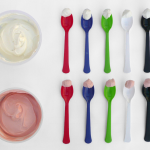When innovating we do not need to always be thinking about the disruptive, earth shattering innovations. Even small innovations in unexpected places can lead to new and better experiences. Take the recent study in the journal Flavour The Taste of Cutlery: How the taste of food is affected by the weight, size, shape and colour of the cutlery used to eat it. by Harrar and Spence. These authors discovered that flavor, sweetness, and texture of food could be enhanced just by changing the cutlery the food was served with. Additionally, the perceived cost of the food was also changed due to the cutlery.
Results: The results revealed that yoghurt was perceived as denser and more expensive when tasted from a lighter plastic spoon as compared to the artificially weighted spoons; the size of the spoon only interacted with the spoon-weight factor for the perceived sweetness of the yoghurt. The taste of the yoghurt was also affected by the colour of the cutlery, but these effects depended on the colour of the food as well, suggesting that colour contrast may have been responsible for the observed effects. Finally, we investigated the influence of the shape of the cutlery. The results showed that the food was rated as being saltiest when sampled from a knife rather than from a spoon, fork, or toothpick.
We can easily see how this bit of information regarding small changes can still lead to a totally brand new perspective. This stimulus shows us that what we thought were just knives, forks and spoons were actually actively affecting the eating experience. Looking at meal time from the cutlery perspective turns the utensils into a larger innovation opportunity area, without being disruptive at all. This type of information extends well beyond the restaurant. How do nutritionists help those that need to reduce there salt intake still have salty tasting foods? How can lower fat foods be made to taste more rich using cutlery? How can the weight of packaging or the free spoon in the package turn something ordinary into something extraordinary? There are many more (of course, this stimulus does suggest a path for disruptive innovation – how does cutlery get re-engineered to become even more active in affecting the eating experience?) Research like this supports the idea that even the smallest changes can be part of successful innovation campaigns.

Different Colors: Even the smallest changes in color lead to differing perception of the food being served.
When getting ideas onto paper, small details like these can help flush out the possibilities and show the potential directions new innovations can take. These small bits should be leveraged in a huge variety of ways when the ideas are brought to life so each can be experienced to see if they measure up.
Even small details that typically are not considered important can be the foundation for new and different innovations. It is also a reminder that to make the most of our innovation journey we need to look far and wide for a variety of different stimulus. A variety of stimulus helps develop new and different perspectives from which to view the innovation possibilities.
Are you familiar with any further examples of how this type of information might be leveraged? Let us know in the comments!




